Change is difficult for individuals, and even harder when it comes to companies. Even though change is necessary to grow and keep up with adapting markets, it can be challenging to coordinate and can cause resentment and a lack of productivity among employees.
Luckily, business strategists have developed a way to make change easier for businesses. A change management process is the structured sequence that strategic businesses use to make changes happen more smoothly. The goal of change management processes are to reduce friction and resistance to change by managing the human side of changes.
Managing process changes is, of course, a complex goal, and every change management model comes with different steps to help ease the transition period. Picking the right model depends on the nuances of your organization.
If you are preparing for a major change in your business, then here is your guide to using change management processes to make that change as smooth as possible.
Article Outline
What is Change Management?
Before adopting change management for your organization, it’s important to understand what this term encompasses. The change management process is the name for an approach to guiding a business through transition. The goal is to change the way a business operates systemically instead of haphazardly.
Change comes with a lot of uncertainty, which affects both productivity levels and human capital as people feel stressed and confused. By controlling every step of the process, change management seeks to minimize the uncertainty that accompanies change.
The main focus of the change management approach is the human aspect of a business. While change management steps do touch on managing the legal and financial implications of a major change, these changes are usually well handled by other departments. Traditional ways of managing major changes, such as mergers, usually ignored the human aspect of doing business, which proved costly in the long run.
There are a few different models for change management, each with different steps to make every aspect of the transition easier. Which model you choose will depend on the needs of your company (more on the different models later).
To get the FREE template, click here.

The History of Change Management
Even though the research behind change management, which examines how humans react to change, dates back to the mid-20th century, change management as a philosophy is a relatively new development. Research on this topic dates back to the 1940s, when Lester Coch and John French Jr. published papers examining the phenomenon of “resistance to change.”
Because psychologists developed many of the models that are still in use today during the middle of the 20th century, it was a crucial time for change management. However, these methods still weren’t systematized.
Discussion of change management as a systemized process didn’t begin in earnest until the 1990s. Changing business culture and employee-management relationships led to a growing awareness of the importance of human capital when doing business. This was the beginning of taking academic research about human reactions to change and turning it into a process people can act on.
In 1996, John Kotter published Leading Change, which marks the turn toward modern change management thanks to his eight-step approach. From the 1990s until today, most businesses realized the importance of systemized change management approaches (not just pointless consulting about feelings), and change management bloomed into the important practice it is today.
Change Management Terminology
As you research more about change management, you’ll probably come across terms you’ve never heard of before. Here is some common terminology in the field.
Change Management Processes
Change management processes are all-encompassing systems that map out the steps and techniques to help a company transition smoothly. This is an umbrella term for all of the documents, steps, and tools that make up change management.
Map your change journey: Explore this article, “How Business Process Mapping Helps You Manage and Scale Your Business,” for a framework to visualize and optimize your change management process. Click here.
Change Management Plans
Before starting a transition, every company needs a plan. Change management plans are documents that outline how to transition an organization with minimal disruption.
They can be new documents created for a specific transition or left over from a previous major change. Plans are important because they help systematize a transition and prepare employees for any future changes.
To learn how to develop change management plans, click here.
Change Management Models
Change management models are preexisting concepts, theories, and guidelines for how to transition a company through a period of change. There are many different models that break down change into different steps. The benefit of a change management model is that you don’t have to invent a transition process from scratch; just plug in the model into your organization.
To learn more about the various change management models, click here.
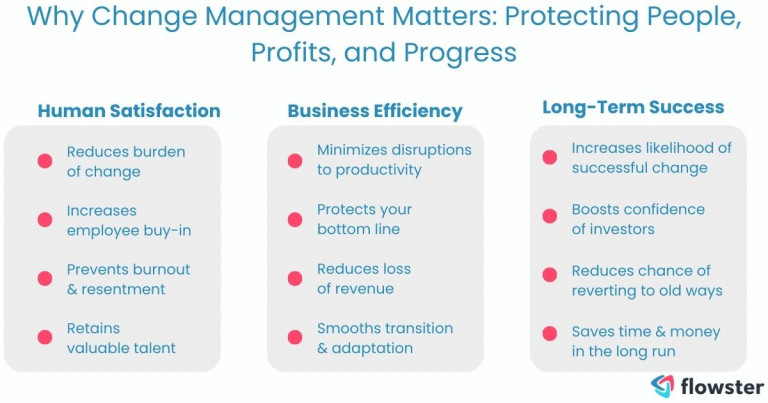
What are the Benefits of Change Management?
The effort of developing a change management process is worth it when you look at all of the benefits. Change management has benefits for the human side of your business.
Employees will feel more enthusiastic and prepared for changes. Employee buy-in will make the transition process easier because people will be more willing to put in extra work or make sacrifices if they understand the point of the change.
Change management creates more structure and support, even during uncertain periods. One important aspect of change management is thorough documentation, which makes future changes or reversing the change, if necessary, much easier.
Documentation also makes it easier to evaluate the change process, make adjustments, and identify any kinks with the new way of working that need to be worked out. Change management also increases your company’s chance of success with the desired change.
Change management makes for a more controlled transition, ensuring that the physical outcome will be closer to the change that management envisioned. It also builds a stronger foundation for the new way of doing business or any further change you want to implement.
Workflow chaos? Conquer it! Discover the secrets to documenting workflows for stress-free task management in this insightful article: “How to Document Workflows for Easy and Efficient Task Management.” Click here.
Benefits of Change Management
Employee-focused benefits:
- Increased employee enthusiasm and preparedness: Employees feel informed, invested, and ready to adapt to new ways of working.
- Enhanced employee buy-in: With an understanding of the “why” behind the change, employees are more willing to contribute and make adjustments.
- Smoother transition process: Reduced resistance and increased cooperation lead to a less disruptive implementation.
Organizational benefits:
- Improved structure and support: Structured processes and thorough documentation facilitate smoother change and future adjustments.
- Easier evaluation and course correction: Documentation enables ongoing assessment and refinement of the new way of working.
- Increased chance of success: a controlled transition mitigates risks and maximizes the likelihood of achieving desired outcomes.
- Stronger foundation for future changes: Streamlined processes and employee buy-in pave the way for future transformations.
Overall, change management leads to a more positive, efficient, and adaptable organization.
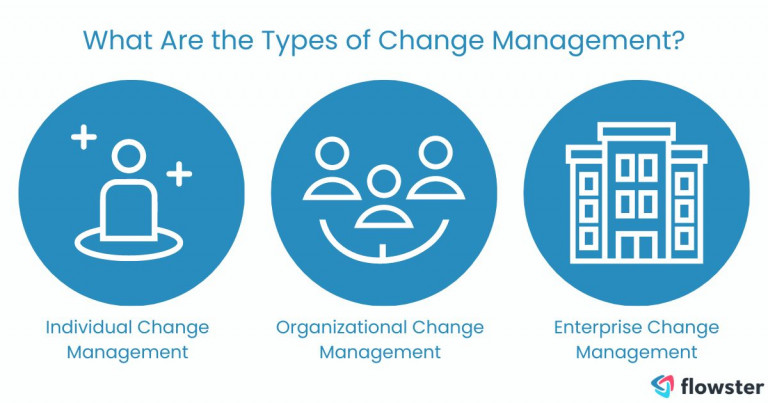
What are the Types of Change Management?
Change management is a broad term that actually describes several different processes. Here are some of the types of change management you will commonly see mentioned.
Individual Change Management
Individual change management is a person-to-person form of change management. The goal of this type of change management is that each person within the organization understands his or her duties, can communicate clearly, and overall feels happy with the change.
Most individual change management is done by lower- or mid-level managers in their interactions with employees. Individual change management is about using workplace psychology to communicate effectively and manage the emotions of everyone on the team.
Organizational Change Management
Organizational change management is a step above individual change management. Instead of dealing with the emotions of individual employees, organizational change management seeks to optimize transition periods by looking at change within the workplace.
Organizational change management gets its name because it focuses on the organization of a department or workplace. This includes adapting workplace procedures to new processes, removing existing obstacles to productivity, and organizing training sessions if the change means employees will need new skills.
Organizational change management would not be possible without individual change management because reorganizing the workplace requires employee buy-in, which does not happen if people feel slighted and ignored by the transition.
Enterprise Change Management
Enterprise change management is the type of change management that takes the most macro-level approach to transition. Enterprise change management looks at the entire company, including all different departments, locations, offices, and management levels, and develops a plan for how all those components can continue to work together.
If just one department within the company is getting reorganized, enterprise change management is still needed because that change could affect interdepartmental cooperation. The goal of enterprise change management is to ensure that the organization as a whole functions smoothly.
Enterprise change management can include reorganizing different departments, developing new methods of communication, or checking in with parts of the organization that are halting the transition and seeing what support they need.
Change Management Models
As mentioned above, there are many change management models that can help you provide a strong base for your change initiative. Here are some of the most common ones.
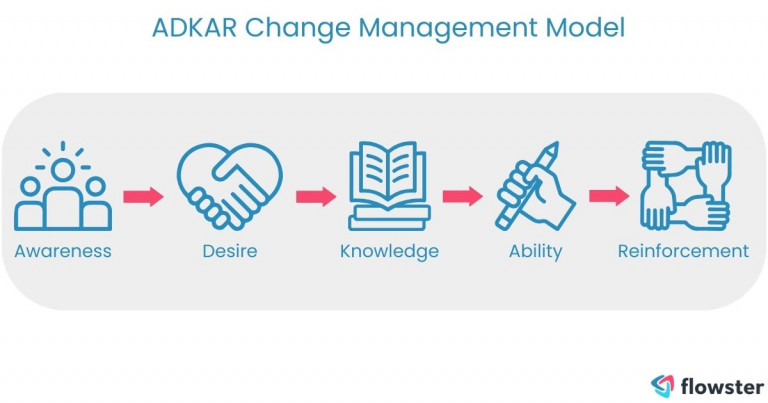
ADKAR Change Management Model
The ADKAR change management model was created by the founder of Prosci, a change management program. It breaks down change management into five steps, highlighted by the acronym, which stands for Awareness, Desire, Knowledge, Ability, and Reinforcement.
The first is awareness of the need for change. That means realizing that your organization needs to change and sharing that realization with others. If people think the status quo is fine, they will be less willing to buy into your change initiative.
Once people are aware that your company needs to change, the next step is implementing the desire for change. That means building buy-in among key stakeholders, from management to employees.
Then, you can proceed to give employees knowledge about how to facilitate the change. This includes sharing your plan for transitioning, providing additional skills training, and educating people about any new responsibilities.
Finally, you can move on to ability, or make sure that you can actually make the transition happen. Through coaching and encouragement, motivate employees to put their knowledge into action and lean into the transition.
The AKDAR model adds an additional step, reinforcement. Even after the change, you want to make it sustainable to prevent regression to past habits.

Lewin’s Change Management Model
Another common change management model comes from psychologist Kurt Lewin, who used psychology to study human reactions to change. Also called the “Unfreeze-Change-Refreeze” model, it breaks change management into three steps. First, you need to “unfreeze” your organization, or prepare it for change. Then, implement the change with as much employee feedback as possible. Finally, “refreeze” the company, or stabilize the change, and make sure new habits stick.
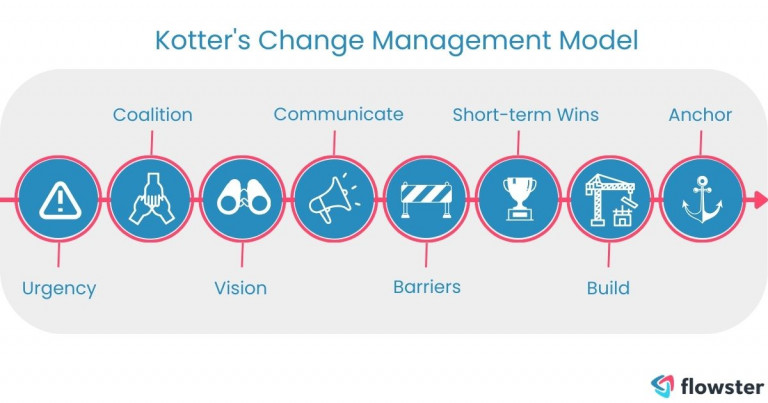
Kotter’s Change Management Model
The next model for change management comes from Harvard University professor John Kotter. Kotter breaks change management processes down into eight steps. While this is more complex than other change management models, the extra detail is welcome if you need more guidelines on how to implement change management processes.
The steps in Kotter’s model are:
- Create urgency: At least 75% of the whole company needs to understand the need for change for the process to be successful.
- Form a coalition: Make sure that you have the right people on your side who will help you bring the change into reality.
- Create a vision: A guiding vision can help people focus on the goal and understand why change is necessary, as well as provide a cohesive narrative even when things get confusing.
- Communicate: Your vision is not worth anything if people don’t know about it! This is also a step where you can find volunteers in your organization to spread your vision.
- Remove barriers: Obstacles will come up during the transition, but remove or evade them.
- Create short-term wins: Success is motivating, so long plans with no end in sight can be discouraging. Celebrate milestones along the way to galvanize people.
- Build on it: However, don’t stop at your short-term wins. See if you can scale up and use this change to launch your company to new heights.
- Anchor it: Make sure the change is a sustainable part of your organization.
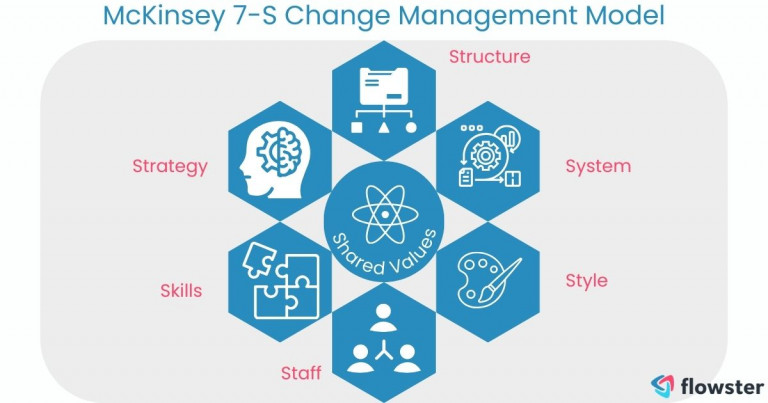
McKinsey 7-S Change Management Model
This next model comes from top consultants and looks at an organization’s structure to implement change. The 7-S elements that make up an organization, according to the model, are shared values, strategy, structure, systems, style, staff, and skills. The change management model looks at which of these elements need adjusting to effect change, then creates a plan accordingly.
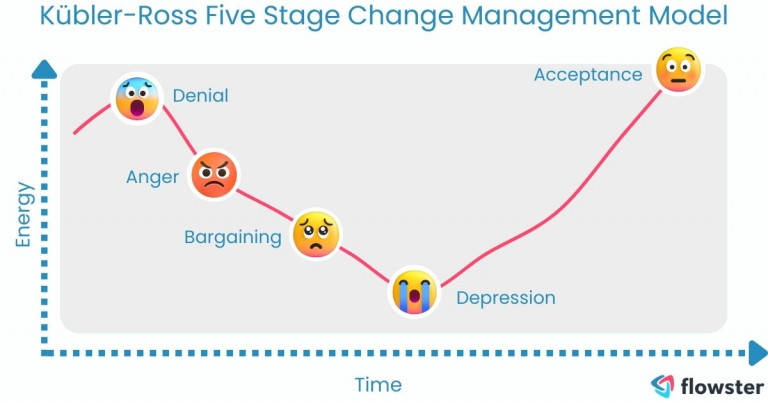
Kübler-Ross Five Stage Change Management Model
This model relies on the psychology surrounding grief applied in a business environment. When humans grieve, they go through five stages of emotions: denial, anger, bargaining, depression, and acceptance, traced on a curve. This process occurs on a smaller scale during any change. In the change management world, using this curve helps predict barriers to change and manage human resources.
What are the Challenges in Change Management?
Change management is an important process with plenty of room for error. Challenges come up during any period of transition, no matter how great your change management plan is.
However, you shouldn’t let awareness of these challenges discourage you. Instead, knowing what some of the most common challenges are can help you prepare for all contingencies.
Human Resistance
Some of the most common challenges come from the people in your organization. Humans are, by nature, resistant to change because it comes with uncertainty, and you will encounter negative emotions no matter how much work you do.
Resistance can come from ordinary employees or even from high-level management. Be ready for resistance, and be prepared to do the work necessary to convince people of the importance of your change.
Curious about tackling people’s resistance to change? Check out Harvard Business Review’s classic take on ‘How to Deal with Resistance to Change’ for timeless insights. Click here.
Communication Breakdown
One way to overcome resistance is through clear communication, but communication is a common challenge in change management. Ensuring that everyone understands the process during a hectic time requires lots of effort, and it is easy to let communication slip by the wayside.
Be sure to explicitly prioritize communication to avoid making members of your organization feel as if they were left out of the loop. The larger your organization, the more challenges you will encounter along the way, as there are more moving parts (and humans) to manage.
Different people may want to increase their input on the chain process, and navigating conflicting chains of command is difficult. Luckily, being part of a larger company also means you have more resources on hand to handle the challenges of change management.
Struggling with communication in change management? Dive into LinkedIn’s insightful guide on ‘How Do You Develop & Implement Change Communication’ for effective strategies. Click here.
Complexity and Resources
Sometimes the biggest challenges in change management don’t come from people but from other factors involved. Managing resources during a process with so many moving parts requires great dedication, and it’s easy to suddenly realize you don’t have enough resources on hand.
Sometimes, change requires introducing new resources, such as technology, that come with their own problems. The good news about these common change management challenges is that many organizations have faced them before and still executed their change management plans successfully.
In fact, many models are aware of these challenges and have built-in mechanisms to minimize roadblocks. You can also anticipate challenges you know will be more likely to crop up given your company’s culture and have resources on hand to meet them.
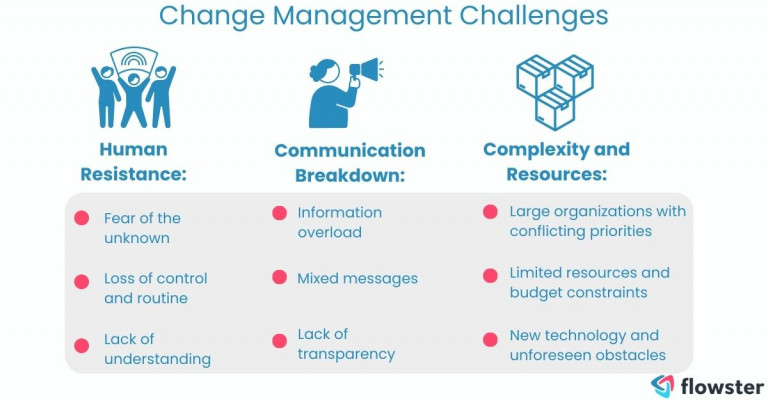
How to Create an Effective Change Management Process for Your Organization
Now that you know what change management is and understand its importance, you can begin the process of developing your own change management procedure. Regardless of the desired change or the model you are using, here are some guidelines to follow when developing the process to ensure maximum success.
- Identify the desired change and goals. You can’t create an effective change without knowing what you are working toward. The first step is to plan your change (as mentioned above) and, most importantly, identify your goals for implementing a change. Keep this in mind as you work through the rest of your change management process.
- Involve key stakeholders and present the business case. To implement a change management process, you need the buy-in of important people, such as management and the C-suite. Create a business case, or a document, explaining the importance of a project through a cost-benefit analysis, which will help overcome any resistance to your proposed change. A business case can also help you articulate the challenges and benefits of the proposed change.
- Determine resources and measurements of success. Part of planning your change management process is creating a detailed road map for how the execution will go. That includes identifying any resources you need, from human to technological to financial, and ensuring you have them on hand. During this step, you should also identify KPIs and milestones that will help you know your project is on the right track.
- Provide clear communication from start to finish. People don’t like feeling as if they are out of control or that decisions are made for them. Make sure that you are communicating directly with people and treating them as equal partners in the transition. During your planning, outline how and when you will communicate with people, because it’s easy to forget during intense work.
- Manage resistance and improve the impact of the change. Resistance is inevitable when change occurs because people don’t like uncertainty. However, with preparation, you can manage resistance and ensure that it won’t be disruptive. Plus, resistance can be helpful because other members of your organization could have feedback on how to improve the change.
- Recognize the change management project’s success. This seems like a frivolous component of change management, but recognizing and celebrating success is an important part of the change! People will put in a lot of effort to implement your project, and they will want to know if their work paid off and to have that effort acknowledged. Celebrate the success of your final change and recognize the fulfillment of milestones along the way.
- Review impact and improve your change management process for the future. After you implement your change, check in with the data you gathered along the way and with your team to see how the change has impacted them. Is there a way the transition could have been smoother? Use this knowledge to prepare change management processes for any future transitions.
FREE Change Management Process Templates
You can streamline the process of getting organized with this free template. They cover every stage of change management, from assessing the need for changes to implementing new procedures and monitoring them as well!
These are easy to use, so you’ll be able to make them work no matter what situation arises—simply click on the “Complete Task” button below to get your copy of this free template.
Effectively Manage Change with Change Management Process Tools
Implementing a change management procedure is a lot of work. However, with the right tools on hand, you can make the process easier, as technology streamlines many of the procedures associated with change management.
One way the right process tool can help is through documentation. A complex change generates a lot of documentation, and you want to store it in one place to refer back to later.
Plus, change management process tools allow you to store documentation and other knowledge in a decentralized way, ensuring that the change management procedure is not entirely dependent on one person.
Change management tools make it easier to manage employees, especially for larger companies. If you are adjusting your workflow, you want to remember what new tasks and responsibilities you assign to people. Plus, many change management tools make it easy to offer employee training within the software itself.
The larger your organization, the more important a change management tool will be. This software can help you manage multiple change management processes and integrates with other organizational tools to ensure the smoothest communication and workflow.
Looking to enhance your workflow with AI? Dive into Flowster’s comprehensive guide, ‘AI-Powered Workflow Management Software: How to Make The Smart Choice,’ for key insights on making an informed decision. Click here.
Transform Your Business with Flowster's AI-Driven Automation
Conclusion
Change management is an important process to learn before your business undergoes a transition, but if you’ve never worked with it before, it can be overwhelming. Luckily, there are plenty of resources online to learn more. Harvard Business School has many online articles tackling change management processes and other important business concepts. For more intensive training, turn to online courses from platforms such as Udemy.
Change is difficult, but it is a necessary part of personal and business growth. With the right change management plan, your business can execute its goals successfully, and your employees can rise to new challenges.
Struggling to write SOPs?
Flowster allows you to easily create standard operating procedures by leveraging AI, or you can browse our library of pre-built SOP templates in the Flowster Marketplace. These templates are intended to meet a wide range of business needs and can be easily customized to meet your specific requirements.
Do you need assistance? Use our “Done for You” services to have our quality and improvement experts create customized workflows for you. Our team can assist you in developing SOPs from scratch, ensuring that they are perfectly aligned with your business processes and objectives.




